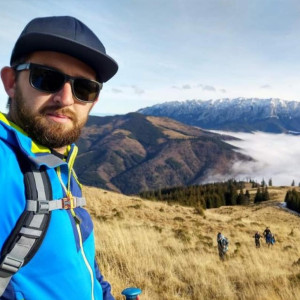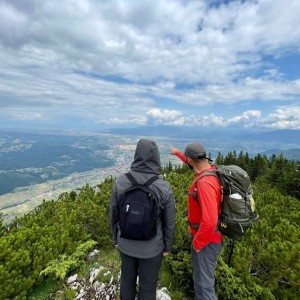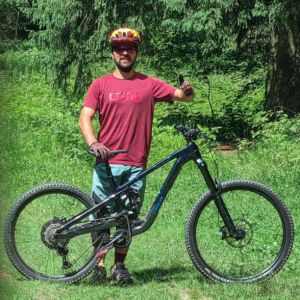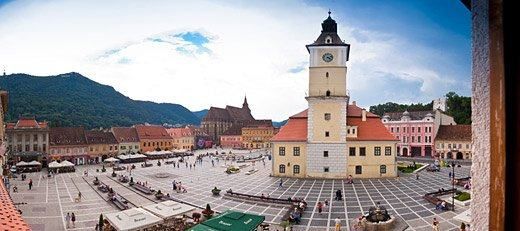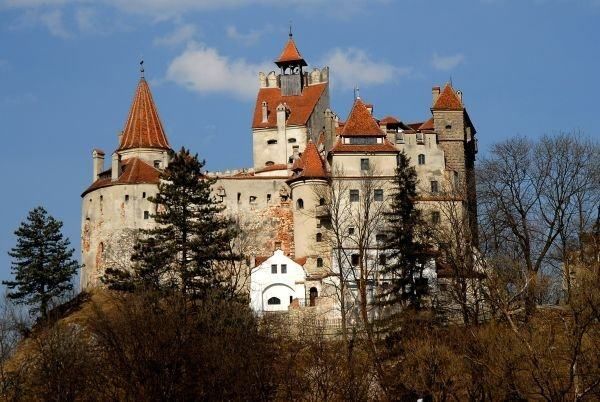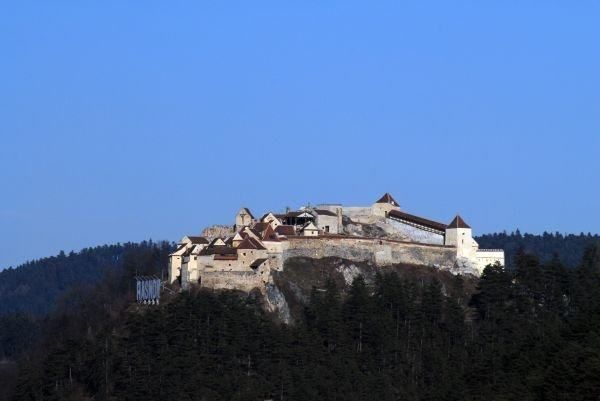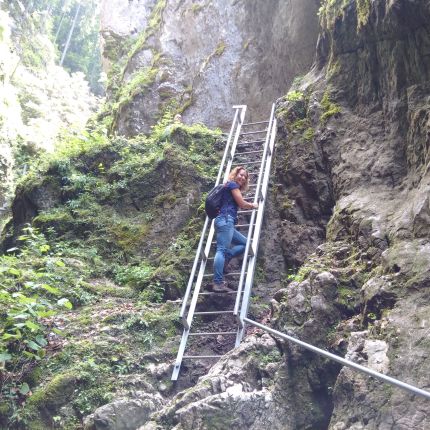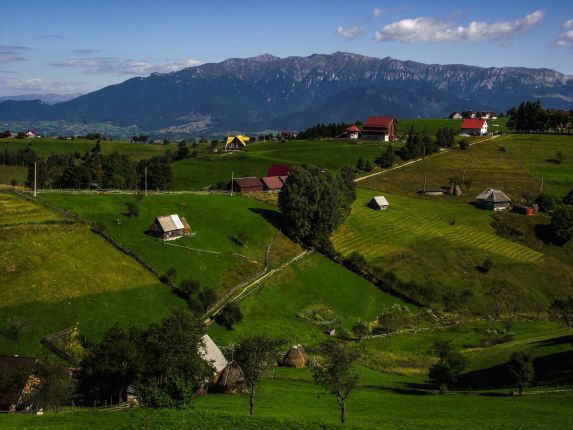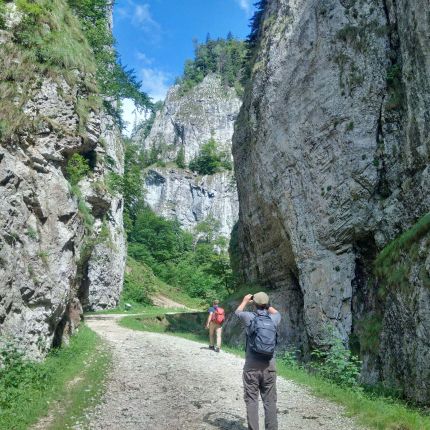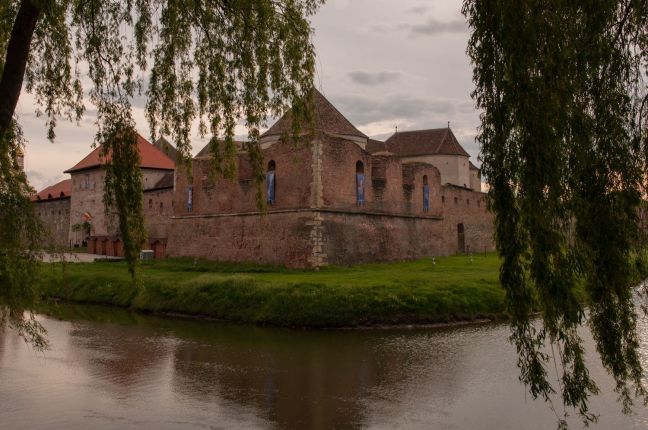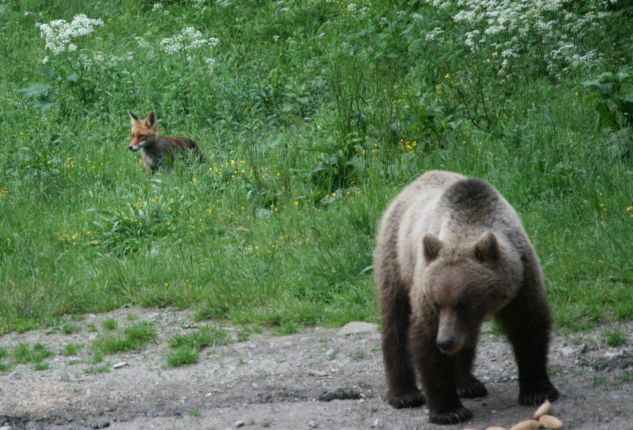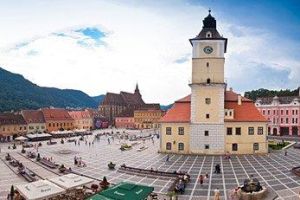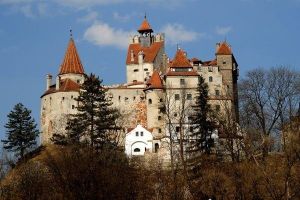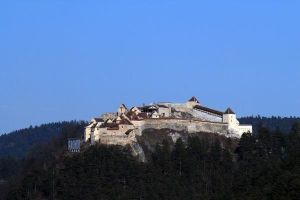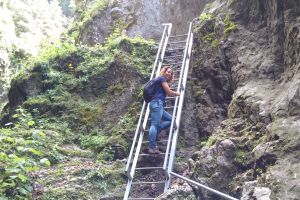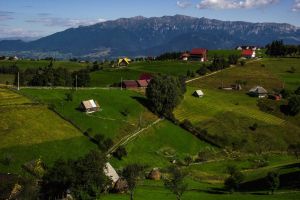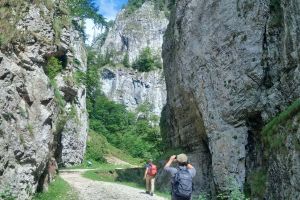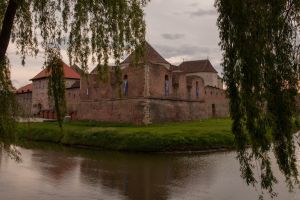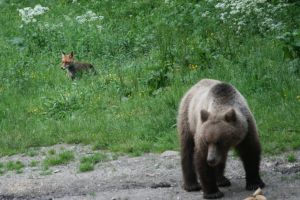
Tours & Day Trips in Brasov
Brasov is one of Romania's most popular tourist destinations famous for its medieval architecture and charming natural surroundings. Surrounded by the Carpathian Mountains, with Bran Castle and Peles Castle nearby, it's one of the best cities to visit during your holiday in Romania! Check our guide for what to do in Brasov to learn more and our suggestions for things to do.
Brasov is 3 hours away from Bucharest and is your entry point into Transylvania. It's a great base to explore the Great Romanian Outdoors, visit medieval castles and traditional villages, go on adventurous tours or wildlife watching! Many of the best things to do in Romania can be crossed off the list from here!
Have a look at our collection of the best day trips in Brasov we selected so you have a great experience, and if you have any questions contact us!
Tour type:
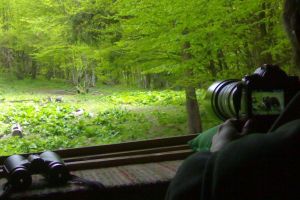
Short Bear Watching Experience from Brasov
Start from: Brasov
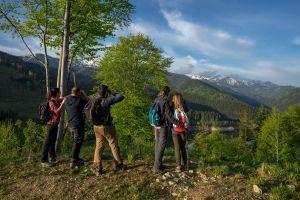
3-day Hiking & Wildlife Trip in the Wild Carpathians
Start from: Rucar village, Arges county
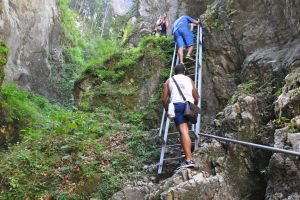
Hiking Trip to the Spectacular 7 Stairs Canyon
Start from: Brasov
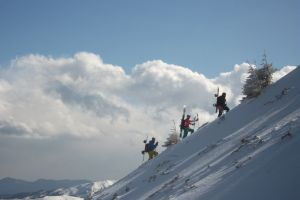
7-Day Carpathian Splitboard and Ski Tour: The Freeride Adventure
Start from: Brașov
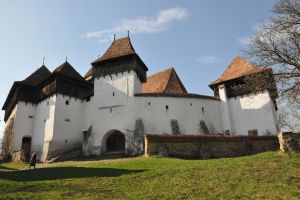
Transylvania Culture & History Day Trip: Viscri, Sighisoara & Rupea
Start from: Brasov
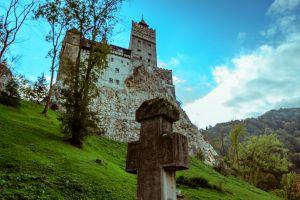
Brasov Day Trip: Bran Castle, Peles Castle & more!
Start from: Brasov
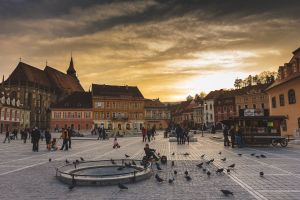
Guided Walking Tour of Brasov: Major Sights & Medieval History
Start from: Brasov
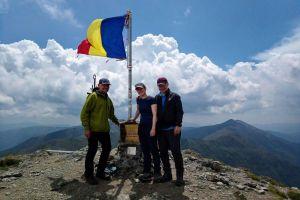
2025 Hut-to-Hut Hiking Trip [7 Days, Shared]
Start from: Brasov
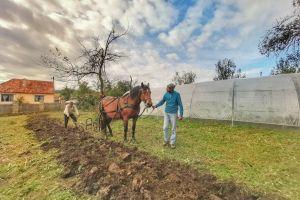
6-Day Volunteer Trip: Farm Life, Tree Nursery & Wildlife Conservation
Start from: Brasov

{{ activity.title }}
Start from: {{ activity.starting_point }}
Reviews about Tours & Day Trips in Brasov

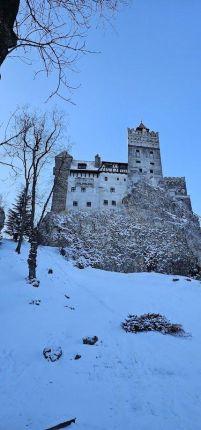
Our day trip to Brasov with Charlie on 14-01-2025 was simply unforgettable. From the stunning Bran Castle to Peles Castle, the Sinaia Monastery, and the fortified church, every stop was a treasure. Charlie was more than just a guide—he felt like family, so caring and attentive, and his passion for sharing the beauty of Brasov was contagious. He was incredibly accommodating to our schedule, full of local insights, and even pulled over to let us capture the perfect shot of Bran Castle on the hillside. His knowledge and enthusiasm made the trip so special. Brasov truly is a jewel, and Charlie’s love for it shines through every moment.


It was amazing to see a wild bear right there in front of us. We learnt so much from Simona and so appreciated her passion and knowledge

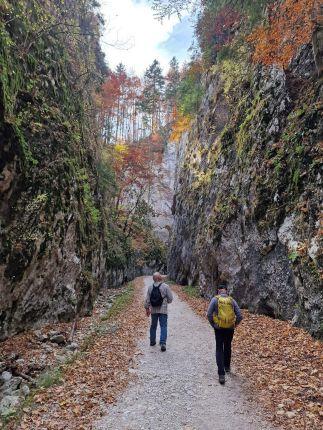
Great tour by Mihai. Lots of information provided about Romanian history and traditional ways of life in the countryside.


Romanian friend were very helpful at making suggestions and arranging a bear watching experience with Simona who was an excellent guide. We saw lots of bears and learnt a great deal.
Best Day Trips and Top Things to Do in Brasov
The city of Brasov is one of Romania’s most popular tourist destinations for locals or foreign travellers alike. Whether you visit the Brasov area on your own or go on a guided tour, you will quickly realise why – representative for our country’s rich medieval and troubled history, with large squares, 700-year-old Black Church, cobbled narrow streets (including the narrowest in Europe – Rope Street, which was used as an escape route for residents in the upper town during fires or invasions), sturdy, colourful and richly decorated houses that belonged to wealthy merchants, Brasov is charming and nothing less! And taking in the fresh mountain air coming from the Carpathian Mountains surrounding the city from all sides is the best way to make your visit even better! Easily accessible via public transport, with the option of either a bus or train journey, or flying in on the recently opened airport, spending one night in the city is a must even if your goal is to visit the nearby Dracula’s Castle! But you should know that the area around Brasov offers some of the best day trips in ROmania: from renowned castles and fortresses, wonderful natural attractions, authentic local life in remote mountain villages, natural parks, and, of course, the famous Transylvania region to which Brasov acts as a gateway. By no means exhaustive, here’s our list of the best tours and day trips in and around Brasov:
- Bran Castle aka Dracula’s Castle
Just to get it out of the way – this is Romania’s #1 tourist attraction and remains the most visited medieval castle on guided tours. It's often the first stop for many tourists in Romania, even after the Covid pandemic. That's why the most popular day trips in Romania will also include a visit to the fascinating Dracula's Castle. Overhyped because of its 'Dracula' association, this attraction is located in the small village of Bran, just 30 km (a half hour drive) from Brasov. The fortress was built around 1377 as a strategic defence fortress and customs pass. Perched on a crest overlooking a valley leading into Wallachia, Bran Castle has menacing towers and truly a medieval air to it. With a long history and passing through many hands and owners, the castle has an interesting history of its own – not at all related to Dracula or Vlad the Impaler, the supposed real-life person for Bram Stoker’s character. The best way to explore Bran Castle is with a tour guide who can offer you valuable insights into the castle's history. Therefore, check our dedicated page and find the cheapest day trips to Bran Castle.
- Peles Castle - The royal construction that marked a world premiere
Romania offers so much more than just Bran Castle, and for those with a fascination for history, numerous castles and fortresses from the medieval period stand as proof of the rich culture of this country. Peles Castle, whose construction commenced in 1873 and was completed in 1914, is situated in the picturesque town of Sinaia, on the medieval route connecting Transylvania and Wallachia. It was commissioned by King Carol I, and it can be found along the Peles River's valley. It also holds a world record as the first castle to be entirely powered by locally produced electricity. Now, its architecture and history continue to captivate hundreds of thousands of tourists each year. Brasov's medieval fortifications and bastions The evolution of the city of Brasov was marked by numerous invasions by Mongols and Turks, a menace that spanned from the 13th to the 15th century. Therefore, during the medieval ages, the townspeople made the decision to fortify their town. This included a 12m high and 3km long wall with seven defence bastions that were erected in key points of the city, each of them entrusted to a guild. That’s how the medieval city of Brasov built a reputation as The Citadel of the Seven Bastions. Although most of the massive walls were demolished in the 19th century as the city expanded, portions of it are still standing. Out of the seven initial bastions, only six stood the test of time and can be visited today on fascinating guided city tours. If you enjoy hearing tales of times long forgotten, these iconic landmarks can provide a fascinating glimpse into the city’s troubled and captivating history.
- The Black Church
The Black Church is a top attraction to visit in Brasov, as it’s one of the city’s most representative historic monuments. Towering over the Council Square and Brasov Old Town, the majestic landmark was built between 1385 and 1477 and remains to this day the largest Gothic church in Eastern Europe.
Originally named the Church of Saint Mary, it got its mysterious name after a fire in 1689 that destroyed a large part of the Old Town and blackened its walls. The Black Church is worth visiting not only because it provides a wonderful example of Gothic architecture, but also because of its exquisite interior where influences from the east and west collide.
You’ll get to see beautiful balconies, mesmerizing stained-glass windows, stone columns, a grand organ, and a collection of wonderful Anatolian carpets, and discover the enthralling history between its walls.
- Tampa Mountain
Brasov is famous not only for its historic buildings and quaint cobbled streets, but also for the stunning natural scenery surrounding it, and Tampa Mountain is a good example of that. Although today most people are attracted by the Hollywood style Brasov sign, there’s more to this mountain than meets the eye. It was at its top where the original citadel was built back in the 13th century. The construction was destroyed in 1458-60 when Vlad the Impaler attacked Brasov, but one can still see its ruins. Overlooking Brasov like a giant nature-clad tower, Tampa Mountain is an ideal place for breathtaking views across the city and intriguing pieces of history. On a guided tour in Brasov, you can visit this beautiful place using the cable car or if you’re feeling adventurous, you can hike to the top on a picturesque alley veiled by trees.
- Rasnov Fortress
Very close to Brasov there is the small town of Rasnov situated at the base of a mountain. On top of this mountain is Rasnov Fortress, one of the best-preserved medieval fortresses in Transylvania and truly a wonderful sight to visit on a day trip from Brasov. Strategically built to allow for maximum visibility of the surrounding area, as you can imagine, Rasnov Fortress was also used to control and defend the entrance into Transylvania. Its defensive system was comprised of nine towers, two bastions, and a drawbridge, and it was quite different from other Saxon fortresses of that time, resembling more with a village. Supposedly built by Teutonic Knights in the 13th century initially out of wood, the Rasnov Citadel was later upgraded to stone and steel through the shared effort of the villagers living in the area who used it as a refuge in times of need. In addition to its breathtaking views, the Râșnov Citadel, a medieval Fliehburg-type fortress, now also features quaint shops and craft stores, making it the perfect place to pick up a souvenir. It's no wonder that it's becoming increasingly popular as a tourist attraction. You can also find a museum behind its ancient walls, displaying a variety of artifacts (including a skeleton preserved under a glass wall), and explore a network of labyrinthian rooms and secret passages that will take you back in time for a short while. To uncover the best places for delving into the history of Romania's diverse regions, visit our dedicated page showcasing tours of castles and historic landmarks
- Rupea Fortress
Another fortress built on top of a hill, Rupea Fortress watches over the town with the same name. Built in the 14th century and constantly upgraded afterwards, it was used to defend and protect the area and the locals living here. Now, it’s one of Transylvania’s most iconic medieval sites, located midway between Brasov and Sighisoara and included in the itinerary of most Brasov day tours. On the Rupea Citadel site, ruins from our 2,000-year-old ancestors the Dacians were found, proving that this place was inhabited for a long time by our ancestors and considered of strategic importance. In fact, during the Dacians, this settlement was called Rumidava and after the invasion of the Romans, it was renamed Rupes (rock in Latin). Rupea Fortress is partially in ruins but it was restored recently and should make it on your list of places to visit if you want to learn about the history of the area and greater Transylvania and see some great views!
- Saxon villages with fortified churches
One of the most interesting things tourists can discover on one of the available Brasov day trips is how well different nationalities lived together. There was harmony in sharing the same living space, while at the same time, keeping each other’s own traditions. This is why people flock to see the Saxon villages every year. Viscri is one of the best-known Transylvanian villages, after having been put on the world tourist map by Prince Charles himself. Tourists come here to see the former Szekely, then Saxon settlement, built around the fortified church. They get to spend the night in an authentic guesthouse and enjoy the peace and quiet of the place, along with some traditional meals. It is a good place to be submerged in the local culture and simple, yet very appealing way of life. A short drive from Brasov, less than 2 hours away by car, can transport you back in time, and that’s why Viscri is a popular tourist attraction included in the best day trips. Founded by the Teutonic Knights, the Prejmer Fortified Church was in the first line of defence against the invaders of the Transylvanian Saxon space. Now, the 13th-century construction, which is the largest fortified church in southeastern Europe, is part of the UNESCO Heritage Sites, calmly welcoming visitors of all nationalities. With Gothic architecture, rounded windows, and solid 3 meters-thick walls, the fortified church provided shelter in the 15th and 16th centuries to the Saxon community in the village, when they needed to flee from the invading Turks and Tatars. It could host locals in up to 300 rooms and it had a special provision system for supplies during the attacks and for supplying the village below in times of peace. In the neighboring county of Mures, you can visit Saschiz, another Saxon village, boasting its own fortified church used as a defensive outpost. And do not worry. Although all of these villages are built on the same model of community taking refuge in the religious edifice in times of war, there are still plenty of differences between every experience. The Saschiz fortress, for example, is by far one of the sturdiest. Also, the community in Saschiz had another fortress where they sought shelter during times of war and where they stored community goods and food in times of peace, the Peasants’ Fortress, up on the hill. A taste of these valuable local foods can be still sampled with some of the many local producers you can find by simply walking through the village.
- Sighisoara Citadel
Once you’ve caught a taste for spending time in a medieval fortress, there is no going back, only going further to explore even more architectural and cultural gems. Luckily, in Romania, you don’t have to go that far. A 2-hour day trip from Brasov by car will take you down a very picturesque road to the citadel of Sighisoara, a 12th-century construction with amazing defensive and locative constructions, restaurants, and cultural venues, that is a UNESCO World Heritage Site. Get your cobbled street-specific footwear and plan on a day looking at colorful old buildings, which are now personal residences, restaurants, boutique hotels, or stores. Sighisoara, also known as the pearl of Transylvania, is one of Romania’s most popular tourist attractions and one of the best-preserved medieval towns in Europe. You could spend days discovering the whole citadel, the lower and the upper part. But when time is short, make sure to visit the center of the citadel, hard to miss since it is a vast open space, right in the middle, with access from the city below from various areas. There are various defense towers, formerly run by the city guilds. But the most famous of all, and accessible from the city center is the clock tower. It strikes on the hour, and it has a wooden figurine carousel depicting the days of the week which is set in motion at the same time. The tower hosts two exhibitions you will not want to miss out on. The lower and the upper parts of the citadel are connected through a covered staircase, interesting to climb. Once you get there, go on a tour of the Church on the Hill and the Evangelical Cemetery. The old citadel of Sighisoara plays host to a number of cultural events, the main one of which is the Medieval festival, the largest of its kind in Romania. It usually takes place in July. Taking a short walk in Sighisoara is a great way to step back in time and experience the medieval atmosphere that envelops you at every turn. During the summer months, Sighisoara attracts numerous visitors. Nevertheless, exploring this historically rich destination remains an excellent choice for tourists to kickstart their Romanian adventure year-round, mainly because it's regarded as one of Europe's most captivating inhabited fortresses.
- The 7 Stairs (Ladders) Canyon
Undoubtedly one of the most popular natural attractions in Romania, the Seven Ladders Canyon is very close to Brasov and makes for a great hiking day trip. To reach the entrance of the canyon, you will pass through one of the beautiful Transylvanian forests. Located in the western part of Piatra Mare Mountains, this Jurassic limestone canyon was formed as a result of natural ruptures, earthquakes, and landslides that happened over thousands of years. If this isn't a good reason to bring your hiking boots to Romania - even if you visit the royal Peles Castle with them - we don't know what is! Similar to a very narrow gorge and 160 m long, the canyon has no less than 9 waterfalls which means there is a small ecosystem with lots of humidity inside. The canyon can be crossed through a series of metal stairs, passageways, and vertical ladders but without the need for specialized equipment. This means you will have a very personal, up-close experience with nature and if you book a guided hiking tour the guide will take you to some of the most beautiful places in Piatra Mare massif! Check our dedicated page for day trips to the 7 Stairs (Ladders) Canyon.
- Piatra Craiului Natural Park
In the Carpathian Mountains, the Piatra Craiului mountains are considered among the most beautiful and exciting for hiking trips. Famous for their sharp limestone ridge that zig-zags across the sky at heights of over 2.170m, this natural park is every hiker’s paradise. Moreover, this incredible natural park provides great options for budget travelers seeking to enjoy a day or two of camping. It offers challenging treks at its ridges but also leisurely trails across hills dotted with remote villages, to admire nature and biodiversity and come across lots of local attractions and friendly villagers. For independent travelers Piatra Craiului can be considered an excellent choice for a walking tour through Romania's impressive natural landscapes. Piatra Craiului National Park has been a protected area since 1938, encompassing a wide variety of wildlife and rare plants, picturesque hiking trails for both beginners and versed hikers, and wonderful small mountain villages. It contains many small-sized natural reservations and attractions such as Zarnesti Gorges, Dambovicioara Cave, Moeciu and Gradistei Canyons, and Curmatura Hut. There are guided day trips or multi-day hiking tours from Brasov or Bucharest that will take you to these sights and we know the friendliest licensed hiking guides for that!
- Picturesque and traditional Romanian villages: Magura, Pestera, Sirnea, Ciocanu
All over the foothills of the Carpathian Mountains, and particularly around Brasov, there are many remote villages dotting the hills with their small houses, haystacks and livestock. Here, aging villagers live like they used to 100 years ago. These villages are representative of the authentic self-sustainable and peaceful rural lifestyle of Romanian culture, where people are very much attached to traditions and customs, community-living, the livestock and land they harvest and work for their daily sustenance.
The villages of Magura, Pestera, Ciocanu, Fundata, Moeciu, and Sirnea, located in Piatra Craiului National Park, are among the most representative. These charming villages provide exceptional opportunities for culture trips, allowing visitors to savor the tranquil ambiance and experience the lifestyles of their inhabitants amidst the towering ridges. These communities live at the highest altitudes in Romania at over 1.200m, nestled between mountain crests and rolling hills. If you plan to visit these villages, it's advisable to opt for a private day trip with a local guide. This way, you'll have the advantage of their knowledge of the area and the ability to interact with the locals and even step into a traditional house, which might be challenging otherwise. That’s why we created our day trip to Magura and Pestera villages which is our best-selling guided tour from Brasov. And the road trip to these isolated areas is an experience in itself!
- Fagaras Citadel
Another interesting historic attraction to visit on a day trip from Braşov is in the city of Fagaras. Dating back to the early 1300s, Fagaras Citadel was also used to defend Transylvania from invaders (obviously!) against the Tatars and later Ottoman Empire. In 1599 the fortress was used as a residence by Mihai the Brave (Mihai Viteazul) an important figure in Romanian history who later gifted it to his wife. It continued to be used as a residence by medieval rulers projecting their power in the area known as Fagarasului Land. The citadel is the perfect history lesson for medieval times and feudal organisation. During the communist regime (1948-1960) Fagaras Citadel was used as a prison for political detainees and a wing of the building is dedicated to remembering and describing those times. Recently, the citadel was restored and now houses the Fagaras Country Museum, where one can admire a vast array of medieval weapons, traditional folk crafts, and Roman artifacts, reinforcing its historical significance.
- Bear watching in Brasov and wildlife tours
Few people know that Romania hosts the largest brown bear population in Europe. Previously hunted for game meat, fur, or simply as trophies or for sport, they are now protected by law. As their numbers grew, bear watching became a popular activity in Romania, and you have the opportunity to see these majestic animals in their natural habitat on a guided day trip from Brasov! Lots of tour guides offer bear-watching tours but you should be careful in choosing the right guides as not all of them are specialised in wildlife activities or will take you on an ethical experience. Our professional guide-partners have been verified by us and can offer you the real and ethical experience with bear tracking or watching and also for other wildlife found in the Carpathians (wild boars, deer, lynx, etc.). Book a guided wildlife tour from Brasov if you want to find out why Romania has been called Europe’s last wilderness reserve! A special attraction in the area is the Libearty Bear Sanctuary, a natural reservation that shelters bears saved from improper captivity from all over Europe. The reservation located in the hilltop forest near the town of Zărnești was open to the public in 2008. Now it’s home to 100 brown bears and can be visited under stricter rules than a zoo because it focuses more on protecting the animals rather than caring for visitors.
- Hiking in Bucegi Mountains
Famous among locals for hiking day trips, Bucegi mountains are the main weekend destination for people living in Brasov, Bucharest, and nearby counties, as they offer plenty of things to do and see for nature lovers. It only takes about 2-3 hours to get to the Prahova Valley resorts and even less to get up a mountain trail. And while the resorts are bustling with people checking into boutique hotels, 4–5-star hotels, B&Bs, local guesthouses, pensions, villas, or apartments, the mountain trails are cool and quiet. Probably the main attraction, accessible by cable car from Busteni and by car from Sinaia, or by foot if you are up for the challenge and don't want to add any extra cost to your Romanian adventure, is the Busteni Plateau. Famous for its wind-carved rock formations called the Sphinx and Babele (Old Women), the plateau is also a destination for yoga practitioners looking for the best place to recharge their batteries. It is said that it is a place with great vibes and high positive energy. Since it is 1600 – 2400 meters high, the view below on a sunny day is breathtaking. If the day is foggy or cloudy, you will see clouds, like from an airplane window. Which is also pretty impressive. Hiking enthusiasts can dare to reach the plateau on a 4-hour hiking trip up the Jepii Mari route, a relatively accessible, yet strenuous hike. The trail is closed in wintertime and special hiking equipment is highly recommended. The Jepii Mici trail is 2-3 hours for people with a high fitness level and it is recommended for going up to the plateau, as most accidents happen if you take this trail to descend to Busteni. If the Jepii Mari trail has mainly wide forest trails, the Jepii Mici trail takes you over the steep rocks, where you will hang on to chains nailed to the mountainside. This is an adventurous trail, but not for people lacking the right fitness level or proper equipment. A light hiking day trip from Brasov to Bucegi Plateau will take you to Heroes’ Cross, or Caraiman Cross. This is an easy hike and should take around 1,5 – 2 hours. The Cross, which can be seen from the Busteni resort as well, is 28 meters high, placed at an altitude of 2284 meters by King Ferdinand of Romania and Queen Mary, to honor the heroes of WWI. Another trail will take you from the plateau to Omu Peak. It’s a 2-hour, accessible hike to the highest peak of the Bucegi mountains at 2507 meters. Even tourists who do not feel confident enough to venture up the mountains can enjoy the beautiful natural attractions of the area. One of the most accessible is Valea Cerbului (Stag Valley), a road taking you from Busteni to the Gura Diham Chalet on a flat road, beautifully surrounded by mountains. This is the starting point for the Diham Cabin trail, a light, 2-hour route accessible to children as well. It is picturesque and relaxing, even though it starts with something the locals call “Fools slope” because just behind the Gura Diham Chalet, there is a very steep portion of the road with gravel. Power through this for about 20 minutes and you will be on an easy path to the cabin situated at 1320 meters altitude, where they serve clean and delicious mountain food, worthy of your effort of getting there. On the other side of Busteni, there is the forest trail toward the Urlatoarea (The Screamer) Waterfall. This is by far one of the easiest trails in the Bucegi mountains for hiking trips from Brasov. However, keep in mind the fact that the trail goes through the forest, so wear warm clothes and hiking shoes as it can get slippery with small streams crossing your path here and there and getting the ground wet. If your hiking day trip starts from Brasov or Sinaia, you can travel by car up to the Padina plateau, on the other side of the mountain from the Bucegi plateau. You can even access the Bucegi plateau by cable car from Padina. Once here, enjoy the green of the high-altitude forest and take the road to Ialomicioara cave, dug deep into the Batrana Mountain. The cave is an impressive mix of galleries and halls even small children can visit and find interesting. Do not forget to get your protective gear (helmets) from the entrance and wear warm clothes as is it chilly in summertime. Upon your descend from the Padina plateau, stop at the Bolboci Lake, an artificial lake also known as the Bucegi Sea. This is a very popular destination, with people coming over for a view of the lake, for a meal enjoyed in the brisk cool mountain air, or for one of the many trails starting from around the lake. As you can tell, the Bucegi Mountains provide visitors with a multitude of wonderful activities, ensuring you experience the very best things nature has to offer.
- Outdoor adventures around Brasov
Lying at the base of Tampa Hill and with Postavaru Massif nearby, Brasov is a great place to go on a bike day trip as the area offers plenty of forest trails including some challenging downhill rides. On a mountain bike tour, a guide will take you on some amazing trails around Brasov with stops along the way to admire the beautiful views of the area. You can even enjoy a snack at a mountain hut or at a vista point!
Brasov is also a great destination for winter sports lovers: nearby Poiana Brasov is considered the best ski resort in Romania but Postavaru Massif is also a great place for off-piste, backcountry freeriding, whether you’re a beginner or experienced rider!
- *The Earth-made Pyramids of the Sun
The Egyptian pyramids are not the only ones surrounded by mystery. At about 70km from Brasov, far away from the bustling city, in a quiet and peaceful atmosphere lies the village of Sona. By looking at its Saxon country houses and the picturesque rural setting, you’d never guess the mysteries hidden in the area.
In the village of Sona, eight peculiar formations arise along a nature trail, creating the most intriguing and unusual view. These pyramid-shaped mounds, around 30 meters high, and covered with vegetation, are surrounded by many local legends and stories. There are scientists who believe that the pyramids at Sona were created by the Dacians and that they shelter King Decebal's tomb, the famous ruler of our ancestors. If you're interested in visiting these captivating attractions, we can arrange a custom day trip for you at the best prices. Feel free to contact us for more details!
 106 REVIEWS
106 REVIEWS
